10 Myths About Drowning Debunked
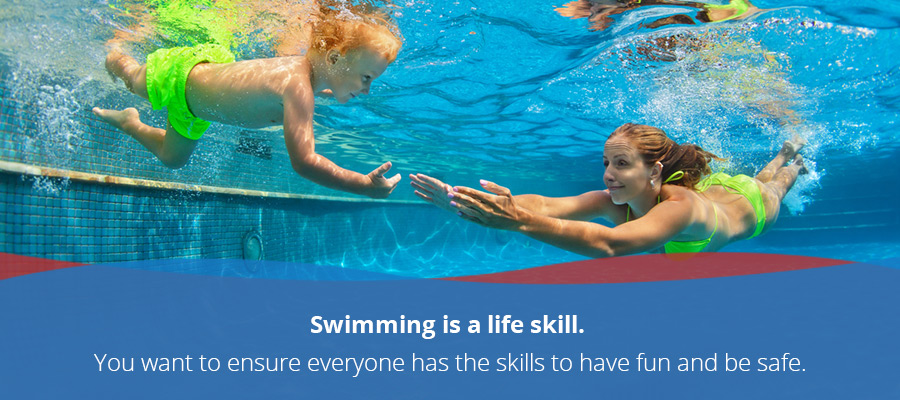
When summertime hits, families flock to pools, lakes, oceans and rivers to cool off. Kids and adults alike love swimming, both recreationally and as a form of exercise. Regardless of when and why you get into the water, it is vital to know proper water safety.
Here are a few drowning statistics that show the truth about drowning.
- Drowning is the third-leading cause of accidental injury-related deaths in the entire world. Each year, approximately 360,000 people drown.
- Ninety percent of children younger than 15 who drown do so in a pool or a spa.
- Men are the highest-risk group for drowning. In the United States, 80 percent of people who drown are men.
Let us debunk 10 myths about drowning and arm you with the information you need to learn effective drowning prevention.
1. Drowning Is a Long Process
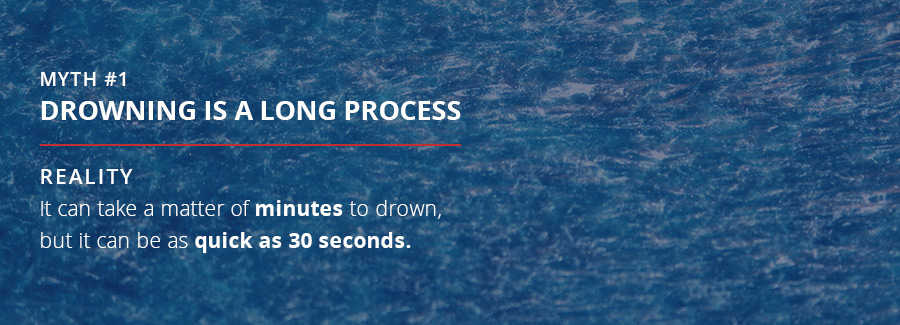
Movies and television frequently portray drowning as a long, drawn-out affair. The struggling swimmer will resurface time and time again. This is possibly one of the biggest drowning misconceptions. A drowning person will struggle for roughly 20 to 60 seconds at the surface of the water. After that, they will no longer be able to remain above water and they will become submerged. Once they are under the surface of the water, time becomes even shorter. It can take a matter of minutes to drown, but it can be as quick as 30 seconds.
Now that you know how fast drowning can happen, here are a few safety tips.
- Always watch your children in the water. It can be easy to get distracted when you are out for a day of family fun by the pool or any other body of water. Though going inside to grab a drink or taking a short nap on the pool chair probably seems harmless, accidental drowning can easily take place in that amount of time. Remain vigilant anytime your kids are by or in the water.
- Know your swimming skills. Children are not the only ones at risk of drowning. It can happen to adults too. When you go swimming, be honest with yourself about your skills. Can you float? Can you tread water? How long can you swim before you become tired? If you are unsure about your abilities, take the time to hone your skills before diving into the water.
- Be familiar with the water. Swimming in a natural body of water is different than swimming in a pool. Conditions can change unexpectedly. When you go swimming in a lake, river or the ocean, educate yourself on the current and tide. If there are warnings posted about dangerous conditions, skip swimming that day.
2. Someone Who Is in Danger of Drowning Will Splash and Draw Attention to Their Situation
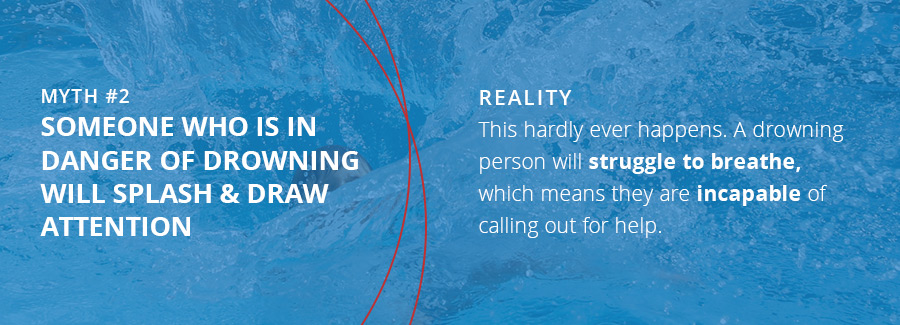
Splashing and calling for help is another classic movie and TV drowning trope. In reality, this hardly ever happens. In fact, 10 percent of drownings occur while an adult is watching and unaware a child is drowning. A drowning person will struggle to breathe, which means they are incapable of calling out for help. A drowning person's head will go above and below water before complete submersion, which makes it difficult to breathe or speak.
Without the classic but untrue signs of drowning, how can you tell if someone is in trouble in the water? When someone is drowning, the body will likely engage the instinctive drowning response. Here are several signs someone is drowning.
- The person's arms are extended. When the instinctive drowning response kicks in, a person will fight to keep their head above the water by extending their arms sideways and pushing down. If you see someone with their arms extended sideways and their face down, it is possible they are in danger.
- The person is bobbing up and down vertically. If a person's body is bobbing up and down vertically with their face near or below the water level, but they are not kicking their legs or moving, this could be a sign of drowning.
- The person is gasping for air. This sign can be harder to catch if you are far away, but if you see someone near you struggling to breathe, ask them if they are alright. If they can't respond, they definitely need assistance.
3. Drowning Only Happens When You Are Underwater
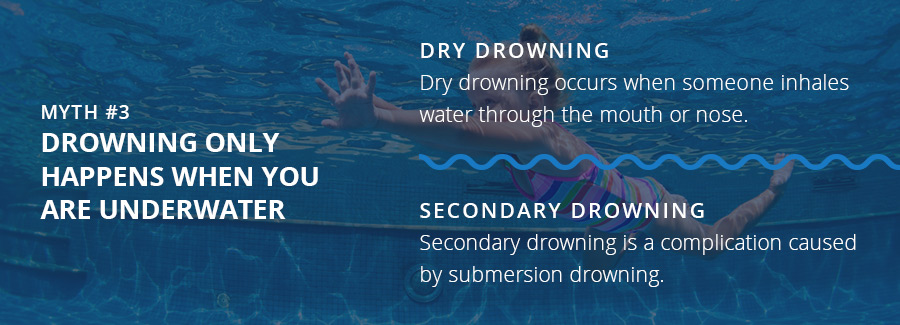
When most people think of drowning, they think of a person underwater in a pool, lake, river or the ocean. However, did you know drowning can also happen in just a few inches of water in your home? For example, it can take just 10 seconds for a child to become submerged in bath water. There are also two types of drowning that can occur when a person is not even in the water. These types of drowning are not as common as drowning by submersion, but they do happen.
- Dry drowning: Dry drowning occurs when someone inhales water through the mouth or nose. The water does not enter the lungs, but it causes the vocal cords to seize up, preventing air from entering the person's lungs. Lack of oxygen means the person is drowning, even though they are not underwater. Signs of dry drowning include coughing, choking and vomiting.
- Secondary drowning: Secondary drowning is a complication caused by submersion drowning. A person rescued from submersion drowning may have water in their lungs. Fluid in the lungs can make it difficult to breathe. Coughing, chest pain and difficulty breathing are all signs of secondary drowning. These signs can worsen over the course of the day after the initial drowning incident. Secondary drowning accounts for just 1 to 2 percent of drowning incidents.
If you notice the signs of dry drowning or secondary drowning in a child or adult, make sure that person receives medical attention.
4. Strong Swimmers Never Drown
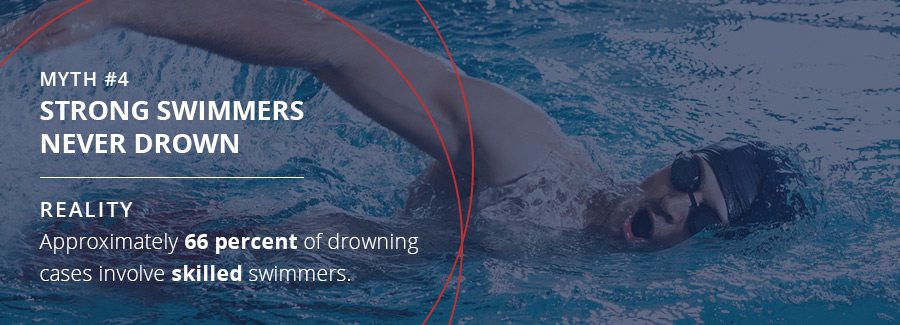
Once you know how to swim, you probably feel pretty confident. You know how to swim different strokes, you can tread water, you can float on your back and you are aware of your limits. While having these skills does help with water safety, they do not mean drowning is impossible. Approximately 66 percent of drowning cases involve skilled swimmers. How can accomplished swimmers drown?
- Unforeseen water conditions: If you are swimming in a natural body of water, you are subject to changes in weather and water conditions. Currents and undertow are powerful forces that can sweep away even the strongest swimmers. Always check water conditions before getting into the lake, river or ocean. If you are unsure about the water, err on the side of caution.
- Shallow water blackout: Strong swimmers like to push themselves to get better. Swimming a certain distance without taking a breath is a common drill for skilled swimmers, but this does not come without risk. The lack of oxygen can result in shallow water blackout, where the person will lose consciousness while underwater.
- Unexpected medical conditions: Leg cramps can happen to anyone while they are swimming. If a person's leg cramps up while swimming, they might not be able to stay above the surface long enough to grab hold of something. Other unexpected conditions like irregular heartbeat can occur to anyone while swimming.
No matter what level of swimming proficiency you are at, follow the buddy system. Always swim with a companion or somewhere with other people present. If something unexpected does happen, there will be other people there to help you.
5. Parents Don't Need to Watch Their Kids When a Lifeguard Is Present
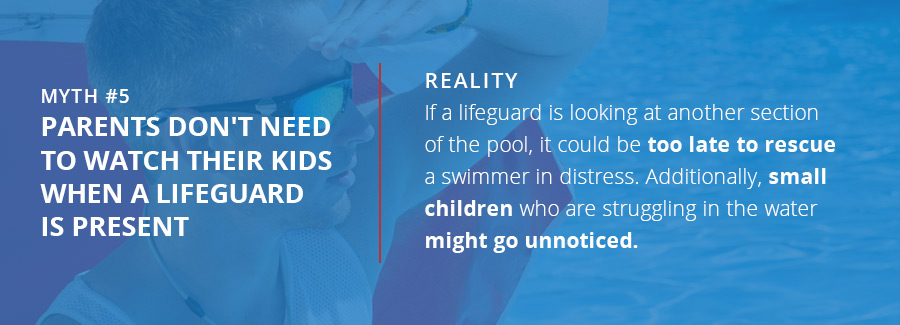
Lifeguards are trained to watch for the signs of drowning, rescue a person in distress and perform CPR. Parents naturally trust these professionals to dive in and save a drowning child. However, there are only so many lifeguards at a crowded pool. Their eyes cannot be everywhere at once. As you now know, drowning can occur in a matter of seconds or minutes. If a lifeguard is looking at another section of the pool, it could be too late to rescue a swimmer in distress. Additionally, small children who are struggling in the water might go unnoticed.
Many pools post signs reminding parents to watch their children. Many pairs of vigilant adult eyes will greatly reduce the risk of a child drowning. When you take your kids to the pool or to a natural body of water, get in the water with them. This way, you can carefully watch them and offer assistance immediately if anything happens. If you want to spend time relaxing outside the water, employ the buddy system. Come with your partner or an adult friend. You can take turns playing and swimming with the kids.
6. Kids Can Skip the Life Vest After Learning to Swim
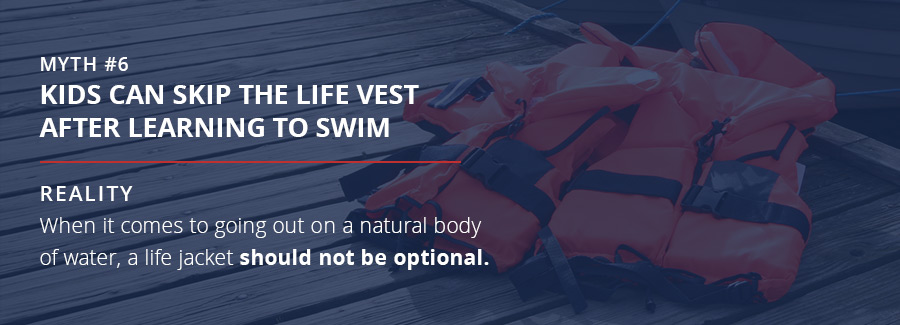
Learning to swim is a big accomplishment. After your kids have mastered the skill, they will probably want to stop wearing a life vest in and around the water. If you are comfortable with your child's swimming abilities in a supervised pool, letting them swim without a life jacket is certainly an option.
When it comes to going out on a natural body of water — whether a lake, river or ocean — a life jacket should not be optional. Life jackets are an important safety measure because they help the wearer float, provide insulation in cold water and make it easier to spot someone in trouble.
If you face a fight with your kids about putting on a life jacket while on a boat or out in a big body of water, remember to always lead by example. Adults should always wear a life vest in these conditions. Make wearing life vests a regular part of spending time on the water so your kids know it is important. Boats can capsize and water conditions can change unexpectedly. A life vest ensures you and your family can safely enjoy your time on the water.
Remember, it is important to find life vests that fit the wearer properly. As your kids grow, you will probably need to replace their life jackets so they can do their job properly.
7. Arm Floaties Will Prevent Children From Drowning
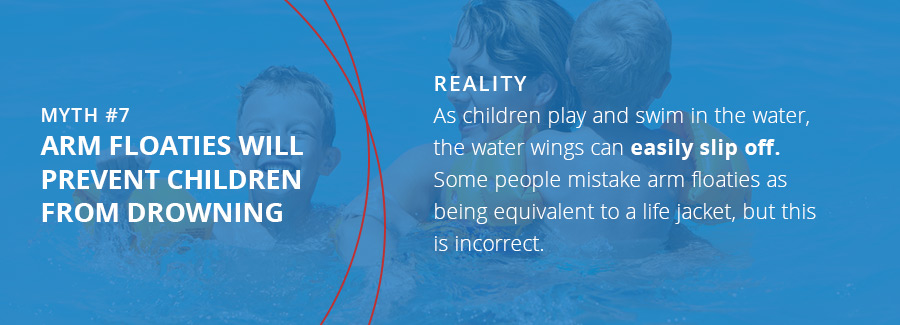
Arm floaties, also known as water wings, are a great tool for helping kids to learn how to swim. The inflatable "wings" slide over the child's arms and offers some extra buoyancy. Kids can use arm floaties while they are getting comfortable with being in the water. While they are helpful, do not mistake arm floaties for lifesaving devices. As children play and swim in the water, the water wings can easily slip off.
Some people mistake arm floaties as being equivalent to a life jacket, but this is incorrect. Life jackets cover the entire torso, and they are designed to tip the wearer onto their backs in the water if they become too tired to swim. That means a person can safely float and breathe until help arrives. On the other hand, water wings can tip the wearer face-first into the water. A child can be wearing arm floaties and still drown. Even when your child is wearing these floatation devices, make sure they are under careful supervision in the water.
Finally, it is important that water wings are a temporary learning tool. Your child should be able to learn how to swim without them. There may come a time when they are unexpectedly in the water without arm floaties. If that happens, you want them to be able to swim on their own.
8. Alcohol and Swimming Are a Good Mix
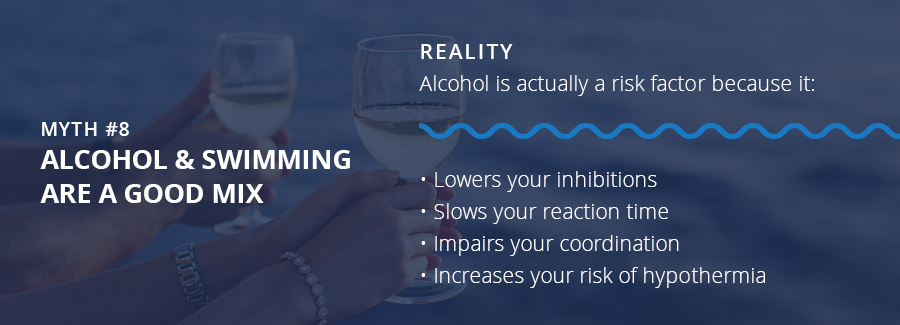
Drinking and swimming is not a concern for kids, but plenty of adults love indulging in beer and cocktails by or on the water. While sun, water and drinks sound like a lovely mix, alcohol is actually a risk factor for drowning. First of all, alcohol lowers your inhibitions and impairs your judgment. That means you might think it's OK to jump into a lake or ocean without checking the water conditions. In fact, this is a risky decision to make and one you probably would not make while sober. There could be riptides or currents you don't know about.
Second, alcohol slows your reaction time and impairs your coordination. If you do enter hazardous water conditions, your body is going to struggle to react properly. Even if the water is completely calm, swimming while drunk can be dangerous. It increases your risk of hypothermia because alcohol increases blood flow to your extremities. Additionally, alcohol can affect the fluid in your inner ear, which regulates balance. If you jump into cold water when intoxicated, the change in your inner ear can make you very disoriented.
Third, never drive a boat while drinking. You would not drive a car on the road while intoxicated, and the same rules apply to boating. Your slowed reaction time and lowered inhibitions are a dangerous mix when driving any kind of vehicle. If you are a passenger on a boat with a designated driver, you might decide splitting a cooler of drinks can be fun. Remember, make sure you are wearing a secure life vest and remain in the boat at all times. Also, remember not to drink in excess. Boating accidents do happen. In case of an emergency, you will still need to be able to swim.
Alcohol is involved in approximately 20 percent of adult drowning cases each year. Postpone happy hour until after you are done swimming, boating, surfing or playing in the water.
9. You Could Drown If You Swim Too Soon After a Meal
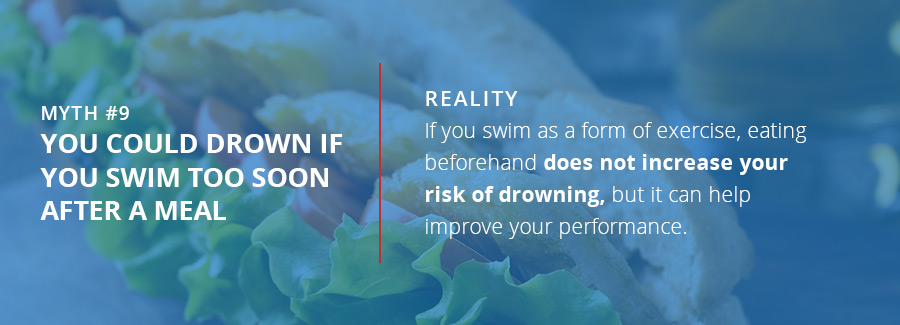
You have probably heard you should wait 30 minutes to an hour after eating before you decide to go swimming. This myth stems from the idea that blood flow involved in digestion will leave your arms and legs too tired to swim or cause uncontrollable cramping while you are in the water. While digestion does require blood flow, it does not leave your arms and legs incapable of helping you swim. If you want to eat a meal or a snack before jumping into the pool, feel free. Keep in mind, though, if you eat so much you feel like you are going to burst, exercise of any kind probably is not on the menu until you feel a little better.
If you swim as a form of exercise, eating beforehand does not increase your risk of drowning, but it can help improve your performance. Eating before a swim workout can help fuel your body and increase your metabolism's efficiency. Plus, you want to stay properly hydrated before you hop in the pool to swim laps.
Forget this myth. You can drop the timer between mealtime and swim time. Just remember to stick to the other basics of swimming safety.
10. You Don't Need to Know How to Swim If You Don't Live Near a Body of Water

There are millions of landlocked people. Just because you do not live by a body of water or own a pool does not mean you do not need to learn how to swim and stay safe in or by the water. Swimming is a life skill. Your kids might not always live somewhere without a major body of water, or you might take a family vacation that brings you to a waterpark or the ocean. Once you get there, you want to ensure everyone has the skills to have fun and be safe. Here are three reasons children should learn how to swim.
- Safety: People love spending time in and by the water. Even if you don't live near a body of water or even a pool, it is likely your child will be in a swimming situation at some point. Maybe it will be at summer camp, at a friend's house or on vacation. No matter the situation, you want to know your child will be safe in the water. Teach them to swim at an early age, and they will have a skill for life.
- Exercise: Swimming is also an excellent form of exercise for both kids and adults.
- Fun: When you follow all the basic rules of water safety, swimming is a fun activity.
Adults should also know how to swim, and it is never too late to learn. Find out if your local pool or community center offers lessons. If you know how to swim, you can lead your kids by example and stay close to them in the water as they learn and play.
Plus, swimming is not the only way a child can drown. Remember, it is possible for small children to drown in just a few inches of water. Make sure you supervise your children anytime they are around water, especially during bathtime, and teach water safety starting at an early age.
Now that you know the facts about drowning, you can feel better-prepared to safely enjoy your time in the water. Check out the swimsuits and gear at The Lifeguard Store so you feel ready to dive right into summer and the pool.



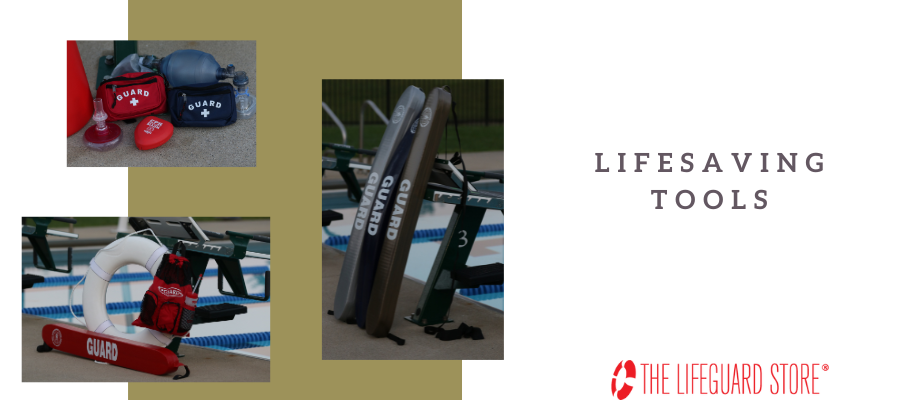
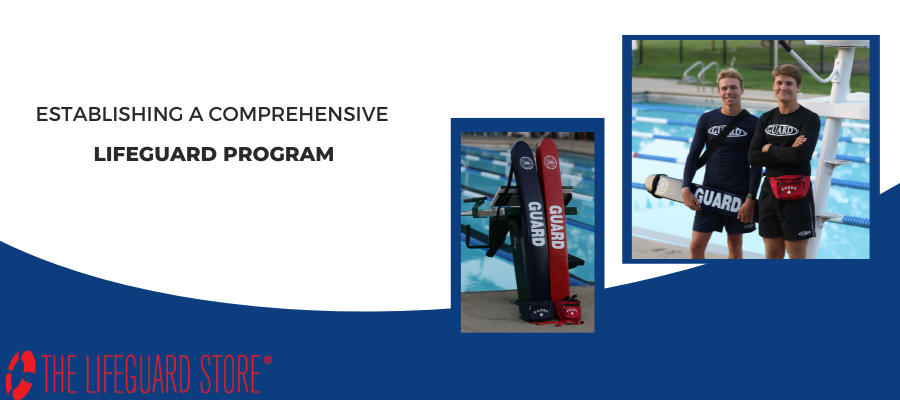
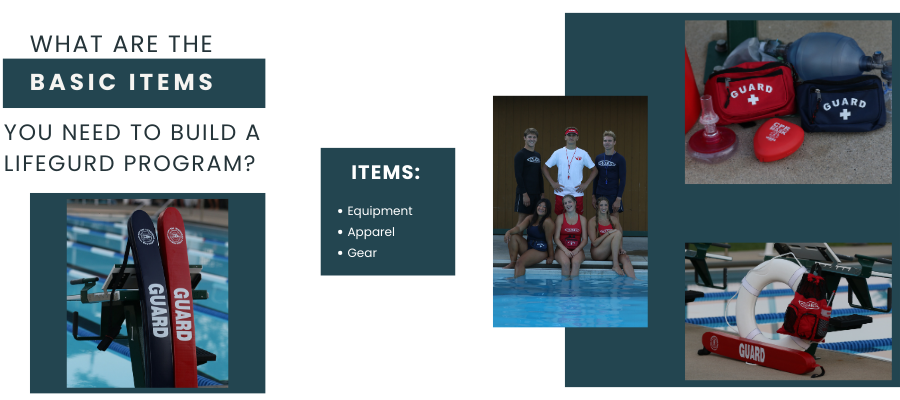
Leave a Comment
Your email address will not be published. Required fields are marked *